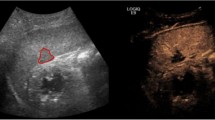Abstract
The purpose of this manuscript is to present current indications and techniques of interventional therapy of heavy bleeding in multiple injured patients using an interdisciplinary approach. It is most important that severe bleeding is quickly diagnosed and treated in those patients with severe bleeding, who are arriving at the hospital. Today various procedures like embolisation, stenting and temporary ballon occlusion are available. These techniques can be used either as stand alone procedures or in combination with surgical techniques. The Multidetector-CT (MDCT) plays a very important role in the diagnosis and strafication of these patients.
Zusammenfassung
Ziel dieser Arbeit ist die Darstellung der aktuellen Indiaktionen und Techniken zur Interventionellen Therapie von schweren Blutungen im Rahmen der interdisziplinären Behandlung polytraumatisierter Patienten. Entscheidend ist dabei, dass bei Patienten mit schweren Blutungen, die die Klinik erreichen, die Blutungen schnell diagnostiziert und therapiert werden. Zur Verfügung stehen heute im Wesentlichen entweder die Embolisation, die Stentimplantation oder die temporäre Ballonokklusion. Diese Verfahren werden dabei entweder alleine oder in Kombination mit chirurgischen Verfahren eingesetzt. Die Multidetektor- CT (MDCT) spielt dabei bei der schnellen Diagnostik und der Stratifizierung der Ptienten eine entscheidende Rolle.
Similar content being viewed by others
Literatur
Gruen G, Leit M, Gruen R, Peitzman A (1994) The acute management of hemodynamically unstable multiple trauma patients with pelvic ring fractures. J Trauma 36:706–711; discussion 711–703
Nix J, Costanza M, Daley B, Powell M, Enderson B (2001) Outcome of the current management of splenic injuries. J Trauma 50:835–842
Hagiwara A, Yukioka T, Ohta S, Nitatori T, Matsuda H, Shimazaki S (1996) Nonsurgical management of patients with blunt splenic injury: efficacy of transcatheter arterial embolization. AJR Am J Roentgenol 167:159–166
Saidi A, Bocqueraz F, Descotes J et al (2004) Blunt kidney trauma: a tenyear experience. Prog Urol 14:1125–1131
Gourlay D, Hoffer E, Routt M, Bulger E. Pelvic angiography for recurrent traumatic pelvic arterial hemorrhage. J Trauma 2005; 59:1168–1173; discussion 1173–1164
Siritongtaworn P (2005) Management of life threatening hemorrhage from facial fracture. J Med Assoc Thai 88:382–385
Shanmuganathan K, Mirvis S, Sover E (1993) Value of contrast-enhanced CT in detecting active hemorrhage in patients with blunt abdominal or pelvic trauma. AJR Am J Roentgenol 161:65–69
Agolini S, Shah K, Jaffe J, Newcomb J, Rhodes M, Reed J (1997) Arterial embolization is a rapid and effective technique for controlling pelvic fracture hemorrhage. J Trauma 43:395–399
Mucha P, Welch T (1988) Hemorrhage in major pelvic fractures. Surg Clin North Am 68:757–773
Ben-Menachem Y, Coldwell D, Young J, Burgess A (1991) Hemorrhage associated with pelvic fractures: causes, diagnosis, and emergent management. AJR Am J Roentgenol 157:1005–1014
Panetta T, Sclafani S, Goldstein A, Phillips T, Shaftan G (1985) Percutaneous transcatheter embolization for massive bleeding from pelvic fractures. J Trauma 25:1021–1029
Chuang V, Reuter S (1975) Selective arterial embolization for the control of traumatic splenic bleeding. Invest Radiol 10:18–24
Sclafani S, Weisberg A, Scalea T, Phillips T, Duncan A (1991) Blunt splenic injuries: nonsurgical treatment with CT, arteriography, and transcatheter arterial embolization of the splenic artery. Radiology 181:189–196
Yao D, Jeffrey R, Mirvis S et al (2002) Using contrast-enhanced helical CT to visualize arterial extravasation after blunt abdominal trauma: incidence and organ distribution. AJR Am J Roentgenol 178:17–20
Kos X, Fanchamps J, Trotteur G, Dondelinger R (1999) Radiologic damage control: evaluation of a combined CT and angiography suite with a pivoting table. Cardiovasc Intervent Radiol 22:124–129
Inoguchi H, Mii S, Sakata H, Orita H, Yamashita S (2001) Intrahepatic pseudoaneurysm after surgical hemostasis for a delayed hemorrhage due to blunt liver injury: report of a case. Surg Today 31:367–370
De Toma G, Mingoli A, Modini C, Cavallaro A, Stipa S (1994) The value of angiography and selective hepatic artery embolization for continuous bleeding after surgery in liver trauma: case reports. J Trauma 37:508–511
Richardson D, Franklin G, Lukan J et al (2000) Evolution in the management of hepatic trauma: a 25-year perspective. Ann Surg 232:324–330
Duncan I, Wright N, Fingleson L, Coetzee J (2004) Immediate endovascular stent-graft repair of an acute traumatic rupture of the thoracic aorta: case report and subject review. S Afr J Surg 42:47–50
Lawlor D, Ott M, Forbes T, Kribs S, Harris K, De RG (2006) Endovascular management of traumatic thoracic aortic injuries. Can J Surg 48:293–297
Verdant A (2006) Endovascular management of traumatic aortic injuries. Can J Surg 49:217; author reply 217– 218
Orend K, Pamler R, Kapfer X, Liewald F, Gorich J, Sunder-Plassmann L (2002) Endovascular repair of traumatic descending aortic transection. J Endovasc Ther 9:573–578
Amabile P, Collart F, Gariboldi V, Rollet G, Bartoli J, Piquet P (2004) Surgical versus endovascular treatment of traumatic thoracic aortic rupture. J Vasc Surg 40:873–879
Ott M, Stewart T, Lawlor D, Gray D, Forbes T (2004) Management of blunt thoracic aortic injuries: endovascular stents versus open repair. J Trauma 56:565–570
Lin P, Bush R, Zhou W, Peden E, Lumsden A (2006) Endovascular treatment of traumatic thoracic aortic injury–should this be the new standard of treatment? J Vasc Surg 43 (Suppl A):22A–29A
Dunham M, Zygun D, Petrasek P, Kortbeek J, Karmy-Jones R, Moore R (2004) Endovascular stent grafts for acute blunt aortic injury. J Trauma 56:1173–1178
Author information
Authors and Affiliations
Corresponding author
Additional information
Serie:
Die Intensivtherapie bei Traumen und Polytraumen
Herausgegeben von I. Marzi (Frankfurt/Main)
Rights and permissions
About this article
Cite this article
Mack, M.G., Maier, B., Balzer, J.O. et al. Interventionelle Techniken zur Blutungskontrolle. Intensivmed 45, 19–25 (2008). https://doi.org/10.1007/s00390-007-0792-8
Received:
Accepted:
Published:
Issue Date:
DOI: https://doi.org/10.1007/s00390-007-0792-8




